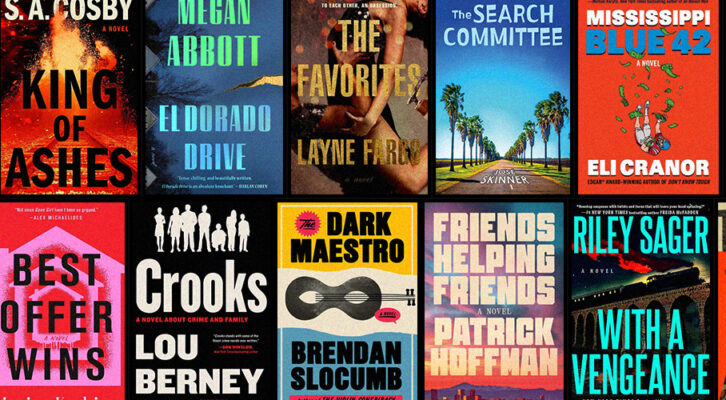
Gatherings Gone Wrong: Five Books Featuring Disastrous Party Scenes
Jonathan Parks-Ramage Explores Brilliantly Bad Fetes in Books by Edward St. Aubyn, Raven Leilani, Deborah Eisenberg, and Others
To be stuck at a disastrous party is a fate with which we’ve all had to contend. There is nothing worse than running into your toxic ex over a tepid cheese plate, or making agonizing small talk with your drunk boss at the office holiday soiree, or being trapped in the stripper-pole party bus on the bachelorette weekend from hell.
Perhaps this is why horrific parties are so fun to read about in fiction—there is a certain pleasure in watching the celebratory train crash without being forced to contend with the real-life wreckage.
My new novel, It’s Not the End of the World, follows what I imagine to be one of the most disastrous parties in the history of literature. The book takes place in 2044 and follows a wealthy gay couple as they refuse to cancel their baby shower, even as a potentially apocalyptic event sweeps through Los Angeles.
To give away the exact nature of the catastrophe would be to spoil the plot, but rest assured that no one is sticking around for cake when the world is quite literally on fire.
In the spirit of honoring those authors who have crafted epically cataclysmic celebrations before me, I’ve assembled a list of novels which feature some of the worst (but most entertaining) parties-gone-wrong.
*

Edward St. Aubyn, Some Hope
Edward St. Aubyn’s five-book fiction cycle, known as the Patrick Melrose Novels, presents a world brimming with greed, decadence, wealth, viciousness, and the very specific brand of toxicity that foments among the British upper class. The books are littered with chicly disastrous parties, which prove to be the perfect settings to showcase Aubyn’s biting satirical wit.
But perhaps the most pivotal party takes place in Some Hope, the third book of the series.
Some Hope follows protagonist Patrick Melrose as he attends an opulent party at the sprawling country estate of a wealthy aristocratic couple. Patrick is newly sober after a traumatic childhood and a young adulthood marked by struggles with addiction.
Though the party has a veneer of glamour, there is a darkness and cruelty lingering just beneath the surface. Over the course of the evening, Patrick encounters people from his past, and is forced to confront the traumas that caused so much anguish throughout his adult life.
Though the subject matter can be heavy at times, make no mistake—Some Hope still bubbles with Aubyn’s caustic wit. So many of the characters are intelligent, cruel, snobbish, yet undeniably hilarious.

Deborah Eisenberg, Your Duck Is My Duck
The eponymous short story in Deborah Eisenberg’s fifth collection opens with the following sentence: “Way back—oh, not all that long ago, actually, just a couple of years, but back before I’d gotten a glimpse of the gears and levers and pulleys that dredge the future up from the earth’s core to its surface—I was going to a lot of parties.”
It is one particular party, however, that sets the narrator on a path that causes her to directly confront corporate greed and destruction. At the event in question, she is invited by a wildly wealthy couple to join them for an all-expenses-paid trip to their beach home, a beautiful estate on an unnamed tropical island. After arriving, it becomes clear that the couple have summoned others to this island as well, for some mysterious and dark purpose.
Gradually, the truth comes out, and the narrator is forced to confront the pain and violence caused by her hosts’ accumulation of wealth. The story vibrates with moral complexity and launches a story collection that is breathtaking in its power and scope.
Eisenberg is that rare breed of writer who is a master of the short form. Each piece brims with sharp wit, sparkling intelligence, and sentences that are a master class in style.

Graham Greene, Doctor Fischer of Geneva or the Bomb Party
This darkly comic tour de force from Graham Greene focuses on Dr. Fischer, a sadistic millionaire who hosts notoriously cruel parties at his lakeside mansion. During these events, he toys with his sycophantic guests, seeing how much humiliation they will endure to stay in the wealthy doctor’s good graces.
His guests gladly endure his punishments because they are gifted expensive objects. Over time, the Doctor increases the stakes—and the violence—of his games, seeing how far his guests will go to satisfy their greed.
Greene’s satirical target is the human capacity for cruelty, and the novel pulls no punches when it comes to criticizing the wealthy. The novel concludes with the eponymous Bomb Party, which features the most chilling of all the Doctor’s evil social experiments.

Raven Leilani, Luster
There are few things sadder than a sparsely attended birthday party. And when that birthday party happens to be for a child, it is particularly heartbreaking. Raven Leilani’s brilliant debut novel Luster features one such scene—a roller rink celebration with a mere two guests and a disco ball disaster which I will not spoil here, other than to say it perfectly encapsulates the feeling of a very bad birthday.
Adding to the particularly impactful nature of this scene, is the fact that it perfectly encapsulates the complicated dynamic between the four main characters of the book. Luster follows the thorny misadventures of Edie, a disaffected publishing employee who enters a somewhat kinky affair with Eric, a digital archivist living in New Jersey.
Surprisingly, Eric’s wife doesn’t banish Edie from their home upon finding out about her husband’s dalliances. In fact, she invites Edie deeper into their family’s life. Soon, Edie becomes a significant role model to Akila, Eric’s adopted daughter, and it becomes clear that Edie may be the only Black person in Akila’s life, adding an intense complication to an already complex dynamic.
Luster brims with dark humor, poignant human insight, and sentences that shine with stylistic verve.

Bret Easton Ellis, The Shards
If the horrific party scenes detailed in Bret Easton Ellis’s semi-auto fictional novel about his youth are even anywhere close to accurate, it will make you very glad you were not friends with him in the 1980’s. The Shards follows seventeen-year-old Bret in his senior year at Buckley, an elite Los Angeles prep school.
Over the course of the novel, Bret becomes increasingly obsessed with the Trawler, a serial killer stalking Los Angeles. Bret is convinced that this murderer is after him, taunting him, and torturing and killing people he knows.
The book takes place well before the term “nepo-baby” was ever conceived, but suffice to say that Bret’s social milieu is composed of some of the richest and most privileged kids in LA. The book is deeply evocative—Ellis transports us to the era of his youth with detailed descriptions of time and place and music and people.
There’s not just one party scene in this book—there are so many, and they each bring a greater sense of the wild world of privilege that Bret occupies. But these parties are not just the site of debauched fun—they are also settings where dark secrets are revealed, tensions boil over, and shocking violence occurs.
______________________________

It’s Not the End of the World by Jonathan Parks-Ramage is available via Bloomsbury.
Jonathan Parks-Ramage
Jonathan Parks-Ramage is a Los Angeles based novelist, playwright, screenwriter and journalist. His critically acclaimed debut novel Yes, Daddy (HarperCollins) was named one of the best queer books of 2021 by Entertainment Weekly, NBC News, The Advocate, Lambda Literary, Bustle, Goodreads and more. Yes, Daddy was also optioned for television by Amazon Studios. He is also the author of It's Not the End of the World (Bloomsbury, 2025).



















